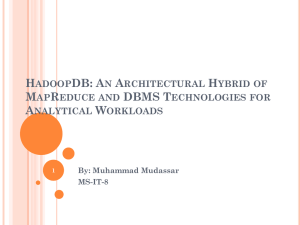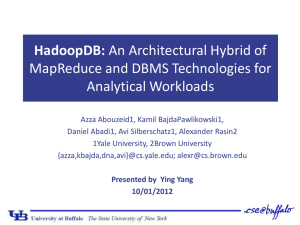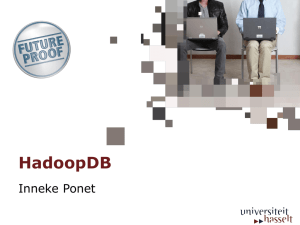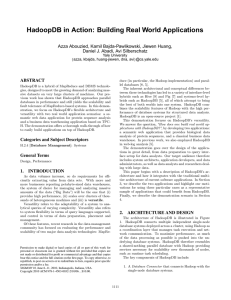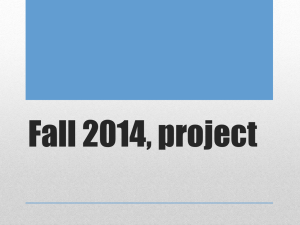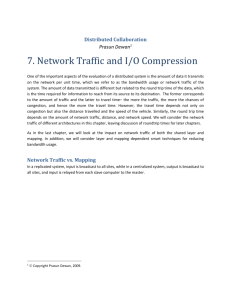Some indexing problems addressed by Amadeus, Gaia and
advertisement
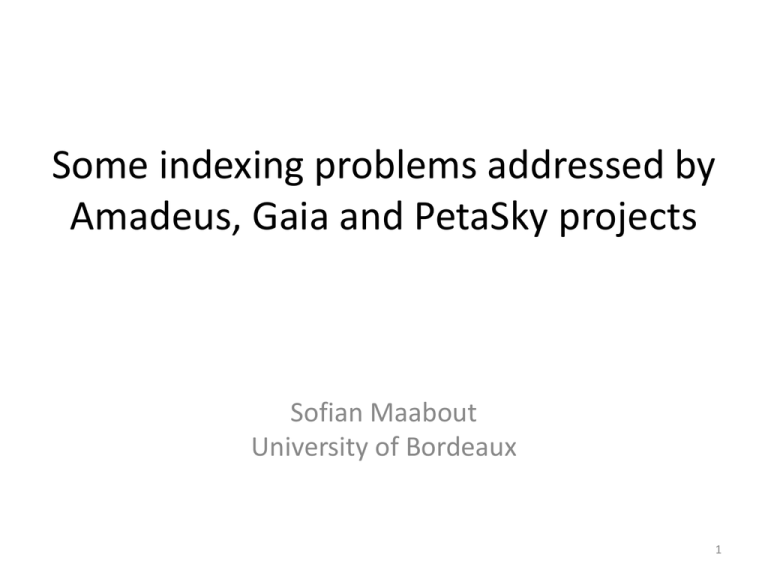
Some indexing problems addressed by
Amadeus, Gaia and PetaSky projects
Sofian Maabout
University of Bordeaux
1
Cross fertilization
• All three projects
– process astrophysical data
– gather astrophysicists and computer scientists
• Their aim is to optimize data analysis
– Astrophysicist know which queries to ask computer scientists
propose indexing techniques
– Computer scientists propose new techniques for new classes of
queries Are these queries interesting for astrophysicists?
– Astrophysicist want to perform some analysis. This doesn’t
correspond to a previously studied problem in computer science
New problem with new solution which is useful.
2
Overview
• Functional dependencies extraction (compact
data structures)
• Multi-dimensionsional skyline queries (indexing
with partial materialization)
• Indexing data for spatial join queries
• Indexing under new data management
frameworks (e.g., Hadoop)
3
Functional Dependencies
•
•
•
DC is valid
BC is not valid
A is a key
AC is a non minimal key
B is not a key
Useful information
• If XY holds then using X instead of XY for, e.g.,
clustering is preferable
• If X is a key then it is an identifier
4
Problem statement
• Find all minimal FD’s that hold in a table T
• Find all minimal keys that hold in a table T
5
Checking the validity of an FD/ a key
• XY holds in T iff the size of the projection of
T on X (noted |X|) is equal to |XY|
• X is a key iff |X|= |T|
• DC holds because |D|=3
and |DC|=3
• A is a key because |A|=4
and |T|=4
6
Hardness
• Both problems are NP-Hard
– Use heuristics to traverse/prune the search space
– Parallelize the computation
• Checking whether X is a key requires O(|T|)
memory space
• Checking XY requires O(|XY|) memory
space
7
Distributed data: Does (T1 union T2) satisfy
DC?
A
B
C
D
a1
b1
c1
d1
a2
b1
c2
d2
T1
A
B
C
D
a3
b2
c2
d2
a4
b2
c2
d3
T2
Local satisfaction is not sufficient
8
Communication overhead: DC?
Site 1
A B C D
a1 b1 c1 d1
a2 b1 c2 d2
1.
2.
3.
4.
5.
Site 2
A B C D
a3 b2 c2 d2
a4 b2 c2 d3
Send T2(D) = { <d2>, <d3>} to Site 1
Send T2(CD)= { <c2;d2>, <c2; d3>} to Site1
T1(D) T2(D) = {<d1>, <d2>, <d3>}
T1(CD) T2(CD) = {<c1;d1>, <c2;d2>, <c2; d3>}
Verify the equality of the sizes
9
Compact data structure: Hyperloglog
• Proposed by Flajolet et al, for estimating the number of
distinct elements in a multiset.
• Using O(log(log(n)) space for a result less than n !!
• For a data set of size 1.5*109.
– There are ~ 21*106 distinct values.
– We need ~ 10Gb to find them
– With ~1Kb, HLL estimates this number with relative error
less than 1%
10
Hyperloglog: A very intuitive overview
• Traverse the data.
1. For each tuple t, hash(t) returns an integer.
2. Depending on hash(t), a cell in a vector of integers V of
size ~log(log(n)) is updated.
3. At the end, V is a fingerprint of the encountered tuples.
• F(V): returns an estimate of the number of distinct values
• There exists a function Combine such that
Combine(V1, V2)=V. So, F(V)= F(combine(V1, V2))
– Transfer V2 to site 1 instead of T(D).
11
Hyperloglog: experiments
107 tuples, 32 attributes
Conf(XY) = 1 – (#tuples to remove to satsify X->Y)/|T|
Distance = #attributes to remove to make the FD minimal
12
Skyline queries
• Suppose we want to minimize the criteria.
• t3 is dominated by t2 wrt A
• t3 is dominated by t4 wrt CD
13
Example
14
Skycube
• The skycube is the set of all skylines (2m if m is
the number of dimensions).
• Optimize all these queries:
– Pre-compute them
– Pre-compute a subset of skylines that is helpful
15
The skyline is not monotonic
Sky(ABD) Sky(ABCD)
Sky(AC) Sky(A)
16
A case of inclusion
• Thm: If XY holds then Sky(X) Sky(XY)
• The minimal FD’s that hold in T are
17
Example
The skylines inclusions we derive from the FD’s are:
18
Example
Red nodes: closed attributes sets.
19
Solution
• Pre-compute only skylines wrt to closed
attributes sets. These are sufficient to answer
all skyline queries.
20
Experiments: 10^3 queries
• 0.31% out of the 2^20 queries are materialized.
• 49 ms to answer 1K skyline queries from the
materialized ones instead of
• 99.92 seconds from the underlying data.
• Speed up > 2000
21
21
Experiments: Full skycube materialization
22
Distance Join Queries
• This is a pairwise comparison operation:
– t1 is joined with t2 iff dist(t1, t2) ≤
• Naïve implementation: O(n2)
• How to process it in Map-Reduce paradigm?
• Rational:
– Map: if t1 and t2 have a chance to be close then
they should map to the same key
– Reduce: compare the tuples associated with the
same key
23
Distance Join Queries
– Close objects should map to the same key
– A key identifies an area
– Objects in the border of an are can be close to
objects of a neighbor area one object mapped
to multiple keys.
– Scan the data to collect statistics about data
distribution in a tree-like structure (Adaptive Grid)
– The structure defines a mapping : R2 Areas
24
Scalability
25
Hadoop experiments
• Classical SQL queries
– Selection, grouping, order by, UDF
• HadoopDB vs. Hive
• Index vs. No index
• Partioning impact
26
Data
Table
size
#records
#attributes
Object
109 TB
38 B
470
Moving Object
5 GB
6M
100
Source
3.6 PB
5T
125
Forced Source
1.1 PB
32 T
7
Difference Image 71 TB
Source
CCD Exposure
0.6 TB
200 B
65
17 B
45
27
join
Group By
Selection
Queries
id
Syntaxe SQL
Q1
select * from source where sourceid=29785473054213321;
Q2
select sourceid, ra,decl from source where objectid=402386896042823;
Q3
select sourceid, objectid from source where ra > 359.959 and ra < 359.96 and decl <
2.05 and decl > 2;
Q4
select sourceid, ra,decl from source where scienceccdexposureid=454490250461;
Q5
select objectid,count(sourceid) from source where ra > 359.959 and ra < 359.96 and
decl < 2.05 and decl > 2 group by objectid; 2-6 returned tuples
Q6
select objectid,count(sourceid) from source group by objectid; ~ 30*10^6 tuples
Q7
select * from source join object on (source.objectid=object.objectid) where ra >
359.959 and ra < 359.96 and decl < 2.05 and decl > 2;
Q8
select * from source join object on (source.objectid=object.objectid) where ra >
359.959 and ra < 359.96;
Q9
SELECT s.psfFlux, s.psfFluxSigma, sce.exposureType FROM Source s JOIN
RefSrcMatch rsm ON (s.sourceId = rsm.sourceId) JOIN
Science_Ccd_Exposure_Metadata sce ON (s.scienceCcdExposureId =
sce.scienceCcdExposureId) WHERE s.ra > 359.959 and s.ra < 359.96 and s.decl < 28
2.05
and s.decl > 2 and s.filterId = 2 and rsm.refObjectId is not NULL;
Lessons
Hive is better than HDB for non selective queries
HDB is better than Hive for selective queries
Group by tasks
250 go
500 go
Q5
Q6
HadoopDB wth
index
HadoopDB
Hive wth index
Hive
HadoopDb wth
index
HadoopDb
Hive wth index
Hive
HadoopDB wth
index
HadoopDB
Hive wth Index
Hive
5000
4000
3000
2000
1000
0
1 To
29
Partitioning attribute: SourceID vs ObjectID
• Q5 and Q6 group the tuples by ObjectID.
• If the tuples are physically grouped by SourceID then the queries
are penalized.
Optimization within HadoopDB
SourceID
ObjectID
SourceID
250 go
ObjectID
500 go
Q5
SourceID
HadoopDB wth
index
HadoopDB
HadoopDB wth
index
HadoopDB
HadoopDB wth
index
HadoopDB
HadoopDb wth
index
HadoopDb
HadoopDB wth
index
HadoopDB
HadoopDB wth
index
HadoopDB
5000
4000
3000
2000
1000
0
ObjectID
1 To
Q6
30
Conclusion
• Compact data structures are unavoidable when
addressing large data sets (communication)
• Distributed data is de facto the realistic setting for
large data sets
• New indexing techniques for new classes of queries
• Need of experiments to understand new tools
– Limitations of indexing possibilities
– Impact of data partitioning
– No automatic physical design
31
